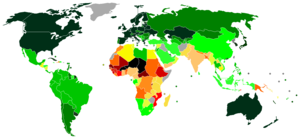- Free and compulsory education till the age of 14
- Development of languages, especially Hindi and Sanskrit, regional languages and introduction of the three language formula
- Equality of educational opportunities
- Development and prioritisation of scientific education and research
- Eradication of illiteracy and provision of adult education
This report has been responsible for the promotion of mathematics and the sciences over social sciences and arts in India and for the development of the hierarchy in public opinion in which a degree in science is considered more prestigious than one in the liberal arts. It stated that the developmental needs of India are better met by scientists and engineers than historians.
The two important policies that form the framework for education in India are the national policies on education effected first in 1968 and then in 1986 (under Rajiv Gandhi govt). NPE 1986 was further reworked in 1992 by the Acharya Committee.
Apart from these, the important legislations relating to education are:
- The University Grants Commission Act, 1956
- The All India Council for Technical Education Act, 1987
- The Institutes of Technology Act, 1961
- National Institutes of Technology Act, 2007
- The National Council for Minority Educational Institutions Act, 2004
- The Copyright Act, 1957
- The Persons with Disabilities (Equal Opportunities, Protection of Rights and Full Participation) Act, 1995
- The National Council of Teacher Education Act, 1993
- The Apprentices Act, 1961
Apart from these, some major education initiatives are/were:
Operation Blackboard (1987 – 1988): Improved the human and infrastructural resources available in primary schools
Restructuring and Reorganisation of Teacher Education (1987): Created a resource for the continuous upgrading of teachers’ knowledge and competence
Minimum Levels of Learning (1991): Laid down levels of achievement at various stages and revised textbooks
National Programme for Nutritional Support to Primary Education (1995): Provided for a cooked meal every day for children in classes 1-5 of all government, government-aided and local body schools. In some cases, grain was distributed on a monthly basis subject to minimum attendance.
District Primary Education Programme (DPEP) (1993): Emphasised decentralised planning and management, and improved teaching and learning materials and school effectiveness
Movement to Educate All (2000): Aimed to achieve universal primary education by 2010 through micro-planning and school -mapping exercises bridging gender and social gaps
Education as a Fundamental Right (since 2001): The right to education for children from ages 6-14 has been a fundamental right under Article 21 (A) of the Indian Constitution from 2001 after the 86th Constitutional Amendment. Recently, in August 2009, the ‘Right of Children to Free and Compulsory Education’ act was passed detailing the provisions relating to free and compulsory education. See also: Directive Principles of State Policy and Fundamental Rights (for other constitutional directives).
Some facts about education in India:
| Item | Statistics 1950-1951 | 2005-2006 |
| Literacy rate | 18.3% | 64.8% (as on 2001) |
| Female literacy rate | 8.9% | 53.7% |
| Schools | 0.23 million | 1.28 million |
| General Colleges | 370 | 11698 |
| Professional Colleges | 208 | 7797 |
| Universities | 27 | 350 |
| Gross Enrolment Ratio in elementary education | 32.1% | 94.8% |
| Gender Parity index at elementary level | 0.38 | 0.92 |
| Public expenditure on education as % of GDP | 1.5 | 3.46 |
The latest trend is to focus on public-private partnerships in the education sector. Some 2,500 model education centres under the partnership model are to going to be setup in the name of ‘Jawahar Kendriya Vidyalaya’. They will be run by private entities under government guidelines.
National Knowledge Commission: It is an advisory body to the PM headed by Sam Pitroda which was given the task of preparing a blueprint to reform education in India; current status unknown.
Pitroda identified five major aspects:
- Improving access to knowledge
- Reinvigorating institutions where knowledge concepts are imparted
- Developing world class academic environments for creation of knowledge
- Promoting applications of knowledge for sustained and inclusive growth
- Encouraging knowledge applications in efficient delivery of public services
Stress was also laid upon the importance of skill development to counter youth unemployment, to be achieved by:
- Introducing vocational education and training (VET) on a large scale
- Linking VET with schools and colleges
- Re-branding efforts to alter perception of VET
Other problems:
- Gross enrolment ratio is around 10-11% lower than 1/4th of developing countries
- Research output is abysmally low with India contributing to only 2.6% of global output (ranked 12th in the world – the bloody Chinese are 5th!)
- Collaboration in research through greater use of technology is necessary; a National Knowledge Network must be created to link institutions to enable live data and resource sharing (where the Indian entrepreneur plays a big role)
[caption id="" align="aligncenter" width="300" caption="World map indicating education index (according to the 2007-2008 Human Development Report)"]
 [/caption]
[/caption]External links:
- Spending on education
- National Mission on Education (through ICT)
- Sarva Shiksha Abhiyan Programme (linchpin of our education system)
- National Programme for Education of Girls at Elementary Level (NPEGEL)
- Mahila Samakhya Scheme (1989)
- Yashpal Committee Report
Related Articles
- India pioneers volunteer-led assessment of educational standards | Madeleine Bunting (guardian.co.uk)
- Look Rich, Think Poor (enderanimate.wordpress.com)
No comments:
Post a Comment